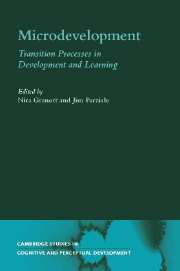Book contents
- Frontmatter
- Contents
- List of figures
- List of tables
- List of contributors
- Microdevelopment: A process-oriented perspective for studying development and learning
- Part I Variability
- 1 Microgenetic studies of self-explanation
- 2 Microdevelopment and dynamic systems: Applications to infant motor development
- 3 Looking at the hands through time: A microgenetic perspective on learning and instruction
- Part II Transition mechanisms
- Part III Micro- and macrodevelopment
- Part IV Context
- Author index
- Subject index
- References
2 - Microdevelopment and dynamic systems: Applications to infant motor development
Published online by Cambridge University Press: 22 September 2009
- Frontmatter
- Contents
- List of figures
- List of tables
- List of contributors
- Microdevelopment: A process-oriented perspective for studying development and learning
- Part I Variability
- 1 Microgenetic studies of self-explanation
- 2 Microdevelopment and dynamic systems: Applications to infant motor development
- 3 Looking at the hands through time: A microgenetic perspective on learning and instruction
- Part II Transition mechanisms
- Part III Micro- and macrodevelopment
- Part IV Context
- Author index
- Subject index
- References
Summary
For many years, the primary occupation of developmental psychologists has been to document the ages at which infants and children reached various cognitive, social, and perceptual-motor milestones. One legacy of Gesell and of Piaget (although not necessarily endorsed by these pioneers) has been elaborate catalogues of “ages and stages” by which to gauge developmental progress and to compare children from different cultures, backgrounds, and family or medical circumstances. A more recent corollary of this tradition is the concern with documenting the earliest evidence of a particular competence. Do three-month-old infants have the object concept? When can babies count?
While we can hardly imagine a developmental psychology not anchored by “age” on the x-axis, a different approach has surfaced in the last decade or so, and is now the topic of this volume. The focus has shifted from “when” to “how.” Microdevelopment is the study of the processes of change, not only the endpoints. It represents a shift in thinking, but also in methods. And it requires new theory, or at least new looks at old theory.
We contend in this chapter that the study of motor development in infancy has been a particularly successful example of microdevelopmental thinking and methods. There are two reasons why this is so. First, the particular theoretical stance that has gained wide acceptance in this domain – dynamic systems – provides both rationale and means for such a genuinely process approach.
- Type
- Chapter
- Information
- MicrodevelopmentTransition Processes in Development and Learning, pp. 59 - 79Publisher: Cambridge University PressPrint publication year: 2002
References
- 26
- Cited by



